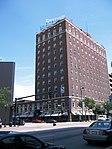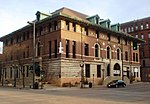Alliant Energy PowerHouse

Alliant Energy PowerHouse (formerly Five Seasons Center and later U.S. Cellular Center) is a multi-purpose arena located in the downtown area of Cedar Rapids, Iowa. It was financed by the approval of a voter referendum to allocate special municipal capital improvement bond monies, after several prior bond referendums to build a civic center failed between 1965 and 1977. The initial construction cost was approximately $7 million for the arena and facilities. The city approved an additional $1 million to build an adjacent multi-level parking facility connected to the center by a skywalk. The center is adjoined by a 16-story DoubleTree hotel facility built directly above the arena.
Excerpt from the Wikipedia article Alliant Energy PowerHouse (License: CC BY-SA 3.0, Authors, Images).Alliant Energy PowerHouse
Cedar Valley Nature Trail, Cedar Rapids
Geographical coordinates (GPS) Address Nearby Places Show on map
Geographical coordinates (GPS)
| Latitude | Longitude |
|---|---|
| N 41.980219444444 ° | E -91.667441666667 ° |
Address
Allient Power House
Cedar Valley Nature Trail
52401 Cedar Rapids
Iowa, United States
Open on Google Maps










